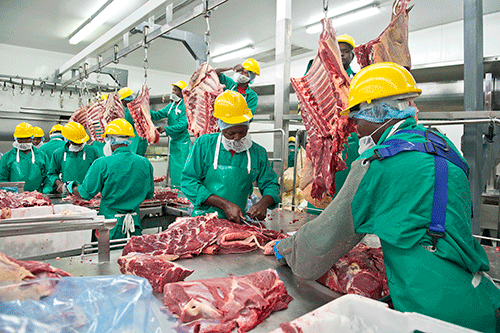Meatco, the country’s largest meat processing and marketing entity, has set plans in motion to revive and turn its Okahandja factory into a fully-fledged value-addition hub, intending to increase efficiencies and produce more value-added products and ready-to-eat goods.
The plans are contained in Meatco’s 2022/23 Integrated Annual Report, which also outlines the entity’s strategic objectives for this year and next year.
Once the Okahandja factory is turned around, it will bolster Meatco’s capacity and capabilities to produce additional value-added products through vacuum packaging, portioning, and pouched-packed ready-to-eat meals for local and regional markets.
As part of expanding its range of wholesale and value-added products, Meatco also plans to open more outlets of its popular MeatMa shops across the country between now and next year, especially in towns such as Katima Mulilo, Rundu and the coastal towns.
The state-owned meat entity, through its MeatMa outlets, recently introduced a new product called the Holiday Braaiwors, which is manufactured using the new sausage production technology, the Freddy Hirsch gel casing method.
On the international front, Namibian beef remained the toast of the European market, as 46% of it was mainly exported to the European Union (EU). South Africa was the second-biggest importer of Namibian beef at 20.5%, Norway (12.9%) and 20.4% to China and the rest of Africa.
Notable is the strong performance of the South African market, which was prioritised for offal and manufacturing beef, with modest amounts of primal and sub-primal beef cuts. Deboned, vacuumed, chilled and frozen cuts, as well as most of the frozen manufacturing beef, was likewise exported to international markets.
As a result of the improved international absorption of Namibian beef, Meatco generated N$865 million in revenue in 2022/23, compared to N$752 million in 2021/22, with international sales generating over N$563.8 million for the fiscal year under review.
The EU accounted for 25% of Meatco’s total revenue, South Africa 11%, Norway 27%, and China/Asia for 11%.
Meatco received 1,200 metric tonnes or 75% of the Namibian portion of the Norwegian quota. As usual, they fully utilised the quota in 2022/23, with forward utilisation of circa 300 metric tonnes to ensure early cash flows and early availability of Natures Reserve in the Norwegian market.
But access to the USA market remained a challenge due to the over- utilisation of the third country beef quota in this market by larger producers such as Brazil, which channelled large portions to the USA due to increased production and restrictions imposed by its traditional markets.
Further challenges were the low beef prices prevalent in the USA when compared to markets such as the EU and Norway, and the mismatch between Namibian beef breeds and production systems and USA demand, which is for more marbled Angus-type cattle.


